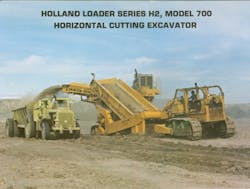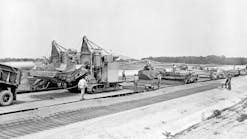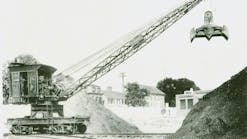One of the most important concepts in the history of construction machinery is that modern equipment very often uses the same principles of design and operation as predecessors from 100 to nearly 200 years ago. One of the most spectacular examples of how modern machines evolved from early designs is the line of massive travelling belt loaders built by Holland Loader Co. of Denver, Colo.
The Holland Loader was originally designed and built by Francis “Mike” Holland. After using a Fresno scraper and a four-up team on the family ranch near Billings, Mont., while in high school, he set himself to the task of finding a more efficient way to move earth. He eventually became a contractor; he settled on Euclid BV traveling belt loaders to do the digging, and a fleet of scrapers and bottom dump trucks as haulers.
The BVs used by Holland experienced a variety of problems that hindered their performance, efficiency and reliability, so he began developing a loader of his own. To improve on the design of the BV, he used a 72-inch conveyor as opposed to 54 inches on the BV, with a reduced slope and cleaner flow of material to and from the conveyor to eliminate clogging. The BV was mounted on crawlers and pulled behind one or two large crawler tractors, but Holland eliminated the costs and inefficiencies of this design by having his loader mounted directly on tractors fore and aft.
One of the first major uses of Holland loaders was at Perris Dam in southern California, where in 1972 and 1973 four of the big rigs loaded out 75,000 to 120,000 cubic yards of bank material per day. Although a number of design problems surfaced during this project, the application was a success after the problems were remedied, and Holland loaders have been used around the world in the years since.
Propelled by a pair of Cat D9s or D10s, Holland’s largest models today are capable of loading 180-ton capacity trucks in less than a minute. Yet for all their tremendous size, power and productivity, these huge machines are exactly the same in concept as the horse-powered elevating grader.
Like the Holland loader, the elevating grader was conceived as a means of excavating bank material and loading it into a vehicle moving alongside the loader as efficiently as possible. While elevating graders came into widespread use in the late 1800s, the earliest elevating grader known to this author was the “ditching plow,” patented in 1854 by John Lyon of Harrisburg, Iowa.
Although some machines are truly new in concept, most of what we see on today’s projects can be traced directly or indirectly to the machines of long ago.
The Historical Construction Equipment Association (HCEA) is a 501(c)3 nonprofit organization dedicated to preserving the history of the construction, dredging and surface mining equipment industries. Information is available at www.hcea.net, 419.352.5616, or [email protected].





